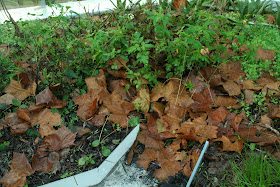Plant matter such as bark, leaves, twigs, nuts and pollen can act as a herbicide, interfering with other plant's cell division, nutrient uptake, photosynthesis, et al. Some plants have strong effects on other plants, preventing growth in some and encouraging growth in others.
 |
| American Sycamore leaves are known for allelopathic properties (maybe they will surpress the Bidens alba!) |
The University of Florida defines allelopathy as, "beneficial or harmful effects of one plant on another plant, both crop and weed species, by the release of chemicals from plant parts by leaching, root exudation, volatilization, residue decomposition and other processes in both natural and agricultural systems."
Plant matter such as bark, leaves, twigs, nuts and pollen can act as a herbicide, interfering with other plant's cell division, nutrient uptake, photosynthesis, et al.
An allelopathic tree usually exerts negative influence on adjacent vegetaion via a number of different processes, including;
- Fog & dew drip
- Leaf litter
- Volatilization
- Sap drip
- Pollen
- Other biological processes
Understanding allelopathy is especially important for green roofs and rooftop gardens with surrounding, adjacent taller trees. Allelopathy can greatly surpress rooftop food production.
According to the University of Georgia, School of Forestry Resources , there are a number of significant allelopathic trees requiring attention when planting other plants nearby. They include;
Strong Potential for Allelopathic Impacts
Acacia spp
Acer saccharum
Ailanthus altissima
Celtis laevigata
Celtis occidentalis
Eucalyptus camaldulensis
Eucalyptus globulus
Eucalyptus spp
Juglans cinerea
Juglans nigra
Leucaena spp
Myrica cerifera
Picea engelmannii
Platanus occidentalis
Populus deltoides
Prosopis juliflora
Prunus cornuta
Prunus serotina leaf
Quercus falcata leaf
Quercus marilandica
Quercus rubra
Quercus stellata
Robinia pseudoacacia
Sassafras albidum
Ulmus americana
Moderate Potential for Allelopathic Impacts
Abies amabilis
Abies balsamea
Abies grandis
Acer circinatum
Acer negundo
Acer platanoides
Acer pseudoplatanus
Acer saccharinum
Aesculus glabra
Aesculus hippocastanum
Aesculus octandra
Arbutus menziesii
Carya illinoensis
Carya ovate
Corylus spp
Crataegus spp
Fraxinus excelsior
Ginkgo biloba
Gleditsia triacanthos
Juniperus monosperma
Juniperus scopulorum
Kalmia spp
Picea spp
Pinus banksiana
Pinus contorta
Pinus densiflora
Pinus edulis
Pinus elliotii
Pinus monophylla
Pinus ponderosa
Pinus sylvestris
Prunus pumila
Quercus alba
Quercus borealis
Quercus douglasii
Quercus gambelii
Quercus michauxii
Quercus shumardii
Rhododendron maximum
Rhus copallina
Sorbus sitchensis
Tsuga canadensi
Slight Potential for Allelopathic Impacts
Abies concolor
Aesculus spp
Betula pendula
Carpinus spp
Casuarina spp
Cupressus macrocarpa
Fagus spp
Fraxinus spp
Larix decidua
Picea excelso
Pinus palustris
Pinus spp
Populus spp
Pseudotsuga menziesii
Quercus petraea
Quercus robur
Quercus rubra
Salix pellita
Sambucus racemosa
Sequoia sempervirens
Taxus brevifolia
Thuja plicata
Tilia americana
Tilia cordata
Tilia planifolia
Ulmus laevis
Ulmus parvifolia
Umbellularia californica
Adjacent to the Breaking Ground Green Roof (see photo above) there are American Sycamores, Platanus occidentalis located in the southeastern and southwestern corners of the living roof. The American Sycamore can produce significant allelopathic influence on adjacent green roof plants. Data exists showing the active ingredients, scopoletin and chlorogenic acid found in the Sycamore leaf may interfere with the ability of stomata on certain plant's leaves to function.
Interestingly, according to the University of Florida's IFAS publication referenced above, allelopathic properties can also be used strategically to control certain weeds, i.e. dried mango leaves surpress nutsedge tubers from sprouting.
Finally, good green roof design incorporates into design the potential and foreseeable effects of adjacent trees and other vegetation. Recognizing and dealing with a potential allelopathic problems during design can save months or years of not knowing why a green roof is barely surviving.
Know the basics of plant allelopathy is you intend to work in green roof design!
Interestingly, according to the University of Florida's IFAS publication referenced above, allelopathic properties can also be used strategically to control certain weeds, i.e. dried mango leaves surpress nutsedge tubers from sprouting.
Finally, good green roof design incorporates into design the potential and foreseeable effects of adjacent trees and other vegetation. Recognizing and dealing with a potential allelopathic problems during design can save months or years of not knowing why a green roof is barely surviving.
Know the basics of plant allelopathy is you intend to work in green roof design!
No comments:
Post a Comment